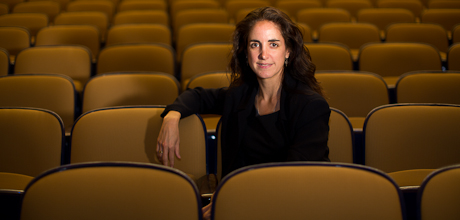The George Washington University recently hired Maryann Lombardi to be Lisner Auditorium’s executive director and director of partnership development. Ms. Lombardi, whose position is part of the Events and Venues office of the Division of External Relations, will focus on expanding Lisner Auditorium’s programmatic offerings as well as building sustainable partnerships between the university and arts organizations, government entities and other groups. Ms. Lombardi sat down with George Washington Today to talk about her new position, her priorities for Lisner and why she hopes to receive a lot more email soon.
Q: Your position is a new one for Lisner. What will you be doing?
A: I’ll work on running the venue—that includes management of the staff, as well as programmatic duties, making sure we’re carrying out a cohesive vision for programming. And I’ll interface with the Events and Venues staff, to make sure we are collaborative in our activities. The position is also partnership-development focused. That entails figuring out how to generate more sustainable partnerships within the institution, as well as with organizations outside of it. For example, we have relationships with arts organizations in the city, but could we be doing more to sustain them, rather than working on one project at a time? We want to make sure we’re serving academic partners, like departments and schools and with students, as well. We could be a much more active participant—if we’re going to program a political speaker, why would we not be talking to the folks in political management or the School of Media and Public Affairs?
Q: What sorts of outside organizations would you like to focus on in developing new partnership?
A: We already work with the Smithsonian Associates and the Washington Performing Arts Society, and we’d love to work even more directly with them, in a more sustainable way. Other arts organizations, and the embassies in general—we could be doing more with them. And we’d like to be more agile and responsive to our partners’ interests, even if it’s not something we have initiated—say with electronic music or rock and pop, for example.
We’d also like to program more with students in mind. We want to program events that interest the students. We’re not pretending we have all the answers, so I’d love to talk to students about what they want to see. We’d like to use social media to see what students want. The University of North Carolina at Chapel Hill is great at this, using social media surveys to find out who students want to see.
We would love to continue the conversation—that’s what I’m most interested in. I would love to hear from members of the GW community about who and what they’d like to see at Lisner. Send me emails and let me know your thoughts. My email address is maryannl gwu [dot] edu (maryannl[at]gwu[dot]edu).
gwu [dot] edu (maryannl[at]gwu[dot]edu).
Q: Lisner Auditorium has such a rich history. What have you learned about it that you will incorporate into your new position?
A: I’m consistently learning more—I’m not an expert yet! One thing is that we don’t have a written institutional history of Lisner. I’ve had a student doing research and we’re combing through it now. It’s really exciting. She’s found a ton of information on Lisner himself—Abram Lisner. She focused a lot on what we don’t know about Abram. There’s a lot out there about [the auditorium’s] performance history, and how it was the center of cultural activity in D.C. and that was at a time when the market [for performance venues] wasn’t as dense as it is now. But the market changes and you have to adapt, and that’s what we’re currently trying to do.
We’re very proud of our history. One neat historical thing is that Lisner has a fire curtain that’s been signed by many, many artists who have performed here during the years. Presidents have signed it—Reagan’s on there. We’re going to get a student to come and help us go through it and index the whole thing, take pictures of each inscription and decipher them. Some are easy to decipher and some are not. We would love to use the index in an interactive way, and add to it as new people sign the curtain.
Q: What are your main priorities for the next year?
A: Programming, programming, programming! Staffing, too, but programming foremost—to fill our house, and to fill it with a diverse program. We have a strong history in world music, and we want to expand it and be the leader in that area. We want to be innovative and produce the big names and the up-and-comers. World music is an anchor for us and we’re proud of it, but we also want a diversity of programming that’s unique and makes us stand out in a way we might not have previously. We want people to say, “I wonder what’s happening at Lisner,” not just, “I want to hear world music, so let’s go to Lisner since they have the best world music acts.”
Q: What are you most excited about?
A: I’m most excited about the people—they’re the ones who make it possible. We can have all these great ideas about programming and community outreach and partnership development, but it’s the people who will make it happen. This venue has been able to succeed and grow because of the people who are running it. I’m excited to work with them and challenge them. I’m excited about the support the university administration has given to [Lisner]. They chose to make this a priority and that takes initiative and passion. Anyone can say, “That’s a great idea,” but this administration has said “That’s a great idea. Let’s actually do it.”


